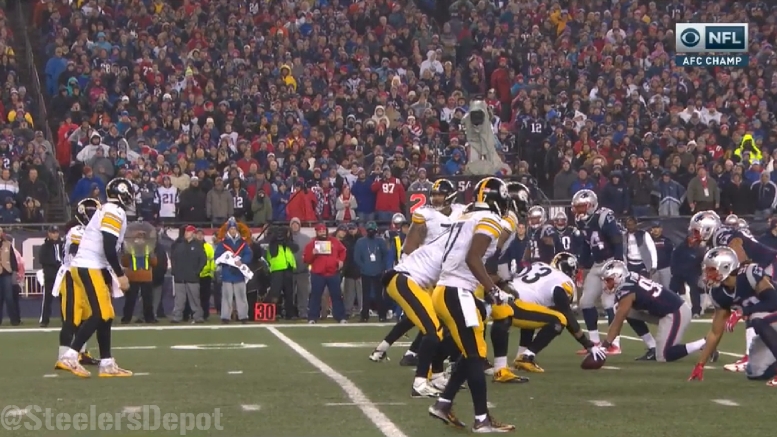Alex just finished up his postseason charting data for the defensive side of the ball, so today we’re going to look at the Pittsburgh Steelers’ offensive charting notes over the course of their three playoff games.
- Personnel formations:
- 10: 2/195 (1%)
- 11: 148/195 (75.9%)
- 12: 7/195 (3.6%)
- 13: 9/195 (4.6%)
- 14: 2/195 (1%)
- 21: 7/195 (3.6%)
- 22: 13/195 (6.7%)
- 23: 2/195 (1%)
- V-32: 5/195 (2.6%)
- As you can clearly see, the Steelers gravitated significantly toward using their staple three-receiver set entering the postseason in comparison to its relative decline in usage over the course of the second half of the regular season. The team used it less than 60 percent of the time down the stretch, so nearly 76 percent is a very significant increase. It’s actually closer to 78 percent if you remove the Victory formation snaps.
- The fullback was only on the field for 11 percent of the snaps, and additional tight end fared little better, seeing multiple tight ends on the field on about 17 percent of the snaps.
- Extra lineman Chris Hubbard saw just 25 snaps over 195, logging just under 13 percent of the total snaps, which is not far from half of the number of snaps that he had been seeing per game during the Steelers’ regular-season winning streak.
- It is somewhat interesting that the Steelers ran four plays in which there were no receivers on the field during their three postseason games, which was not a common sight during the regular season. Those four plays account for the five postseason snaps that Antonio Brown did not take.
- Slot receiver Eli Rogers was the only other receiver to log at least 100 snaps, seeing 150 in total, but only three of them came with fewer than three receivers on the field. The snaps in two-receiver sets were fairly distributed among a number of options.
- How’s this for a trend? Every single snap taken with fullback Roosevelt Nix on the field saw Jesse James replaced by David Johnson. All 21, 22, and 23 personnel formations featured Johnson on the field over James, and all 22 personnel formations featured Hubbard over James as the second tight end.
- There were seven drops by receivers during the postseason, including two by Brown. Sammie Coates had three against the Patriots. James and Cobi Hamilton each also had one against the Patriots, making that five dropped passes in the AFC Championship game.
- The Steelers were blitzed less than 20 percent of the time. Both of Brown’s long touchdowns in the opening playoff game came against blitzes, so perhaps that influenced their opponents’ game plan.
- As has been the case almost all season, play-action has been a virtual non-factor in their playbook, something I lamented on Twitter watching the Falcons use it with success. Nine plays with play-action.
- Average depth of target: 9.2
- Antonio Brown – 10.6 (30 targets)
- Sammie Coates – 22.8 (5 targets)
- Eli Rogers – 7.4 (18 targets)
- Cobi Hamilton – 9.8 (8 targets)
- Demarcus Ayers – 1 (3 targets)
- Darrius Heyward-Bey – 29 (4 targets)
- Le’Veon Bell – .2 (6 targets)
- DeAngelo Williams – 2.1 (8 targets)
- Jesse James – 8.4 (16 targets)
- David Johnson – 0 (1 target)
- Roosevelt Nix – 3 (1 target)








